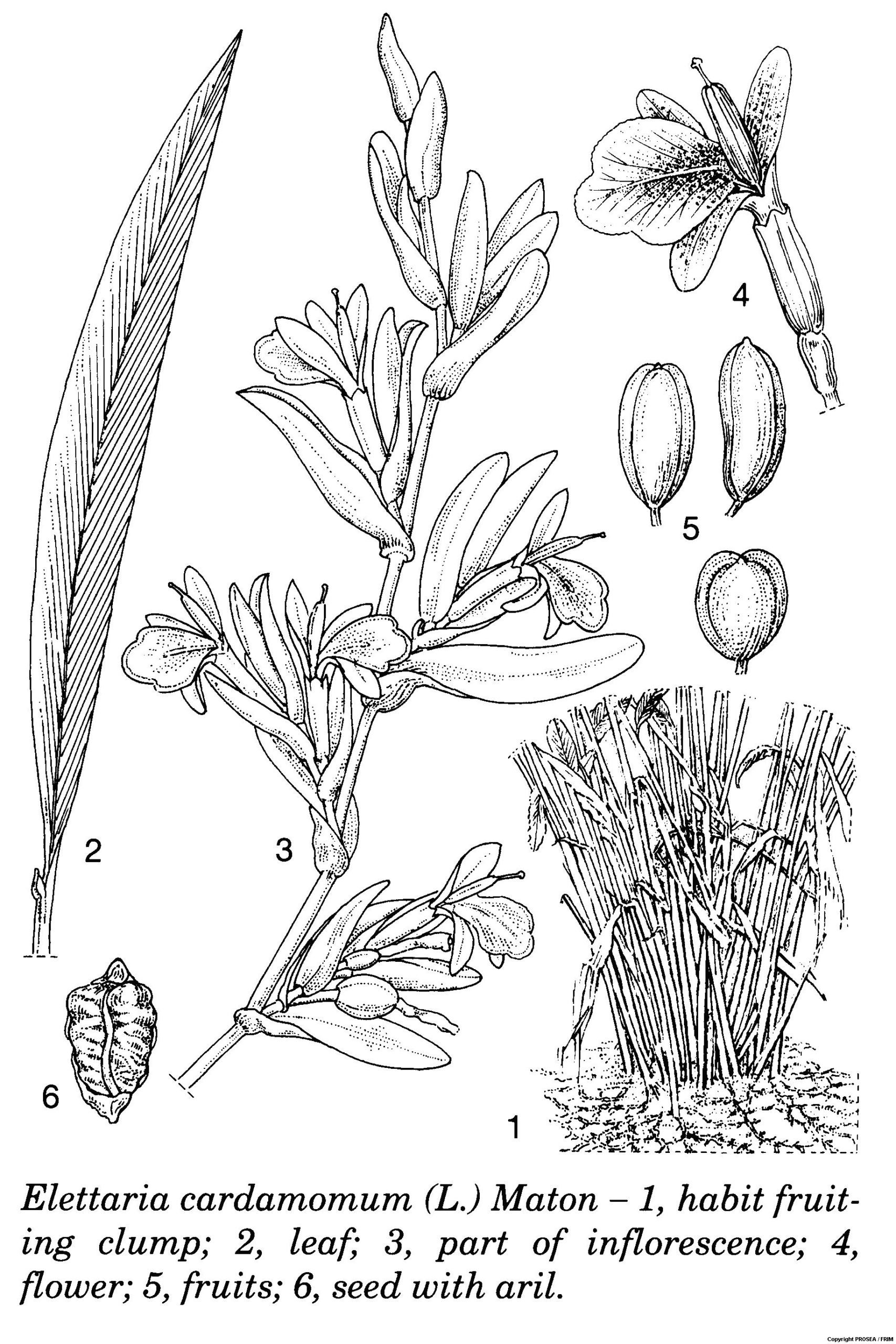Elettaria cardamomum (L.) Maton
Family
Zingiberaceae
Synonyms
Amomum cardamomum L., Amomum repens Sonnerat, Alpinia cardamomum (L.) Roxb.
Vernacular Names
|
Malaysia |
Buah pelaga. |
|
English |
Cardamom, true cardamom, small cardamom. |
|
Indonesia |
Kapulaga sabrang (general), kapol (Sundanese), kapolaga (Sundanese). |
|
Myanmar |
Bala, pala, panlat |
|
Cambodia |
Krako sbat. |
|
Laos |
Hma:k hne:ngx. |
|
Thailand |
Krawan-thet (central). |
|
Vietnam |
Tr[us]c sa, b[aj]ch d[aaj]u kh[aas]u. |
|
French |
Cardamome. |
Geographical Distributions
Elettaria cardamomum occurs wild in gaps in the evergreen montane monsoon forests of the western Ghats in southern India and the western highlands in Sri Lanka. It is possibly also truly wild in Burma (Myanmar), Indo-China and Malaysia, and has been introduced into other parts of the tropics. Introduction into Guatemala in the 1920s was particularly successful and a sizable production and export developed.
Description
Elettariacardamomum is a robust perennial herb which can reach up to 5 m tall. It grows in a thick clump, with branched rhizomes which arise from 10-20 erect leafy shoots (composed of the leaf sheaths) and numerous decumbent flowering shoots.
The leaves are distichous. The petiole (free part) is up to 2.5 cm long, sheathing at the base and forming the pseudostem together with other sheaths. The ligule is entire and measures up to 1 cm long. The blade is lance-shaped, measuring 25-100 cm x 5-15 cm, acuminate at apex, dark green and hairless above while light green and hairless or pubescent beneath.
The inflorescence is a prostrate (seldom erect) panicle, which is up to 1.2 m long. It arises from the rhizome at the base of a leafy shoot. The bracts are arranged alternate, lance-shaped, measuring up to 3 cm x 1 cm and each bract is with an axillary which is usually a 2-3-flowered cincinnus. The bracteole is tubular and measures up to 2.5 cm long. The flowers are bisexual, zygomorphic and measure about 4 cm long. The green sepal is tubular, up to 2 cm long and with 2-3 teeth. The petal is also tubular and 3-lobed. The tube is as long as the sepal. The pale green lobes are 1-1.5 cm long and they are pale green. The labellum is obovate, measures 1.5-2 cm long, up to 1 cm wide, obscurely 3-lobed, and white but streaked with violet. The lateral staminodes are inconspicuous and awl-shaped. The pistil is with ovary 2-3 mm long while the style is slightly longer than the anther. The head-like stigma is small.
The fruit is a spherical or subcylindrical trilocular capsule, measuring 1-2(- 5) cm long, pale green to yellow and brown when drying. There are 15-20 seeds per fruit, which are angled, about 3 mm long, wrinkled, dark brown, aromatic and with thin mucilaginous aril.
Ecology / Cultivation
Evergreen montane forest land supplies the most favorable environment for Elettaria cardamomum, with soils varying from deep forest loam to white quartz gravel with only a shallow zone of humus accumulation. E. cardamomum is a plant of the early succession stage and appears in natural or man-made forest clearings but is not found in forests with an undisturbed canopy. On sloping land, it may grow well in pockets of soil among boulders. In the main production areas in southern India and Sri Lanka, cardamom is grown at altitudes of 600-1500 m. A uniformly distributed rainfall of 2500-3800 mm per year is considered optimal. The tolerable range extends from 1500 5800 mm; months with less than 125 mm rainfall have to be regarded as drought months. Drought periods during the formation of the inflorescence or during flowering will preclude seed production and cannot be overcome by sufficient precipitation at a later stage. Successive droughts in two or more years endanger the plant as a whole. Optimum annual mean temperatures are considered to be around 22°C. The diurnal temperature may vary between 10°C and 35°C. In the lowlands (annual mean temperatures >24°C), E.cardamomum only propagates vegetatively; the plants do not grow where annual mean temperatures are <17°C. E.cardamomum does not tolerate prolonged exposure to direct sunlight; about 50% is thought to be optimal. Strong winds may topple cardamom plants as their root system is weak. Desiccation by dry winds is a serious threat, especially to young seedlings, but may also affect adult plants. The crop does best in little-disturbed soils well supplied with organic matter and, since it does not tolerate waterlogging, it is crucial to have good drainage.
Line Drawing / Photograph
Read More
References
- Plant Resources of South-East Asia No.13: Spices.



